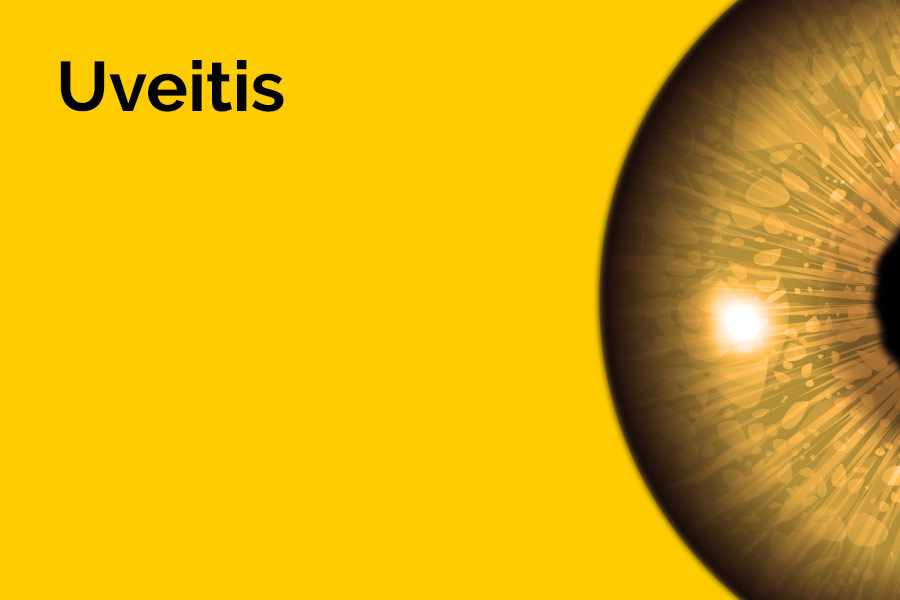Uveitis
Uveitis is inflammation of the central pigmented layer of the eye known as the uvea or uveal tract. Uveitis has different effects on different people depending on which part of the uvea has been affected.
Uveitis can affect people of any age, however, most common between the ages of 20 and 59. It is believed to affect around two to five out of every 10,000 people.
Although it is not a common eye condition it is a leading cause of visual impairment in the UK. Estimates suggest that the more extreme cases of uveitis are responsible for one in every 10 cases of visual impairment in the UK.
One or both eyes can be affected by uveitis with symptoms either developing suddenly or over the course of a few days.
Symptoms
There are several symptoms associated with uveitis. Sufferers may experience a painful red eye. This pain can range from mild aching to an intense discomfort.
Vision may become blurred or cloudy and you may experience increased sensitivity to light (photophobia).
Floaters may appear that move across your field of vision. Floaters may take the form of shadows, webs, dots or veils.
A loss of peripheral vision and regular headaches.
Uveitis can affect one or both of your eyes. Symptoms can develop suddenly or gradually over a number of days.
Diagnosis, Screening and Tests
When you visit an eye specialist (ophthalmologist), they will likely conduct a complete eye exam and gather a thorough health history. You may also require:
- Blood tests
- Analysis of fluid from the eye
- Photography to evaluate the retinal blood flow (angiography)
- Photography to measure the thickness of the retinal tissue and to determine the presence or absence of fluid in or under the retina
If your ophthalmologist thinks an underlying condition may be the cause of your uveitis, you may be referred to another doctor for a general medical examination and laboratory tests. Sometimes it is difficult to find a specific cause for uveitis. However, your doctor will try to determine whether your uveitis is caused by an infection or another condition.
Treatments
When diagnosed and treated quickly, uveitis typically responds well. Common treatments of uveitis include:
Steroid eye drops
Steroid eye drops are usually used to reduce the inflammation in uveitis. They are the main treatment for uveitis and may be the only treatment for mild attacks. Despite steroid eye drops usually working well, in some cases there can be serious side effects, therefore, steroid eye drops can only be prescribed by an ophthalmologist who can monitor the situation.
Treatment to relieve pain and discomfort
Cyclopaedic eye drops
These eye drops are designed to relieve pain by causing the pupil in your eye to dilate. As a result, the inflamed iris is given time to rest and recover. Well-known cyclopaedic eye drops are atropine and cyclopentolate eye drops. There are several known side effects for taking the eye drops. The drops can make your pupils appear larger, and can cause temporary blurred vision and problems with focusing. If the drops are not used the inflammation in the iris may cause it to become ‘stuck’ to the lens leading to permanent scarring.
Wearing dark glasses
If your symptoms include higher sensitivity to light (photophobia), wearing dark glasses (especially on sunny days) will be helpful.
Using painkillers
Painkillers such as paracetamol can help to ease any pain or discomfort.
Steroids by Mouth or Injection
In severe cases of uveitis, steroids are sometimes given into or around your eye. Injections can also be administered by mouth. If used long-term there can be possible side effects. The main side effects from oral steroids occur when they are used for more than a few weeks. Side effects include; thinning of the bones and skin, weight gain, muscle wasting and an increased risk of infection.
Immunosuppressive medicines
If steroid treatment is needed in the longer term to treat uveitis, a second medicine known as an immunosuppressive medicine may be used. This can help reduce the amount of steroids required and/or help to control the uveitis if steroids or not working.
Surgery
Occasionally, surgery may be required to treat uveitis. Surgery will be used in conjunction with other treatments previously mentioned. It is not possible to treat uveitis with surgery alone.
Prevention
Unfortunately, there is currently no way to prevent uveitis. However, wearing protective eyewear during athletic activities, industrial occupations and scientific laboratory work may help to prevent traumatic uveitis. Any activity that involves the possibility of liquid or solid projectiles warrants protection. To help prevent infection, careful hand washing, especially if you have been in contact with sick people, is recommended prior to touching the eye. Proper handling of food also helps to prevent infections such as toxoplasmosis. In conditions caused by sexually transmitted diseases, proper protection helps to prevent the transmission of the disease leading to systematic infection and infectious uveitis.
